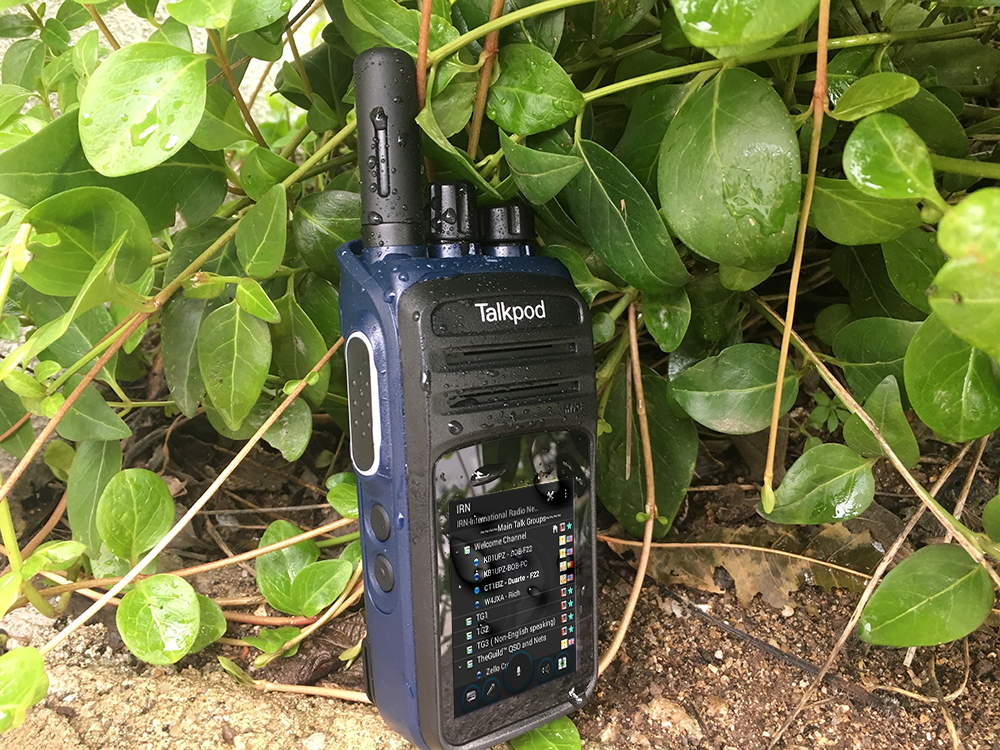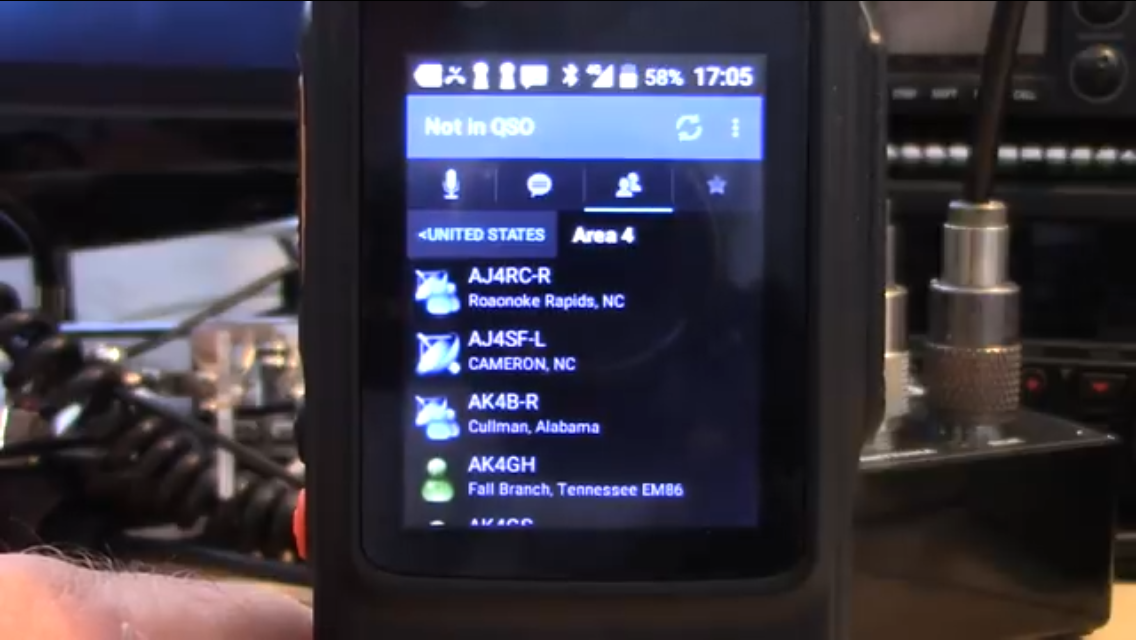
Watch a full video review on the Inrico T320 made by Hamradio Concetps.
As usual, Eric makes an amazing in-depth analysis of the T320 and how it can be used in the various new digital modes.
Watch the video here.

Watch a full video review on the Inrico T320 made by Hamradio Concetps.
As usual, Eric makes an amazing in-depth analysis of the T320 and how it can be used in the various new digital modes.
Watch the video here.
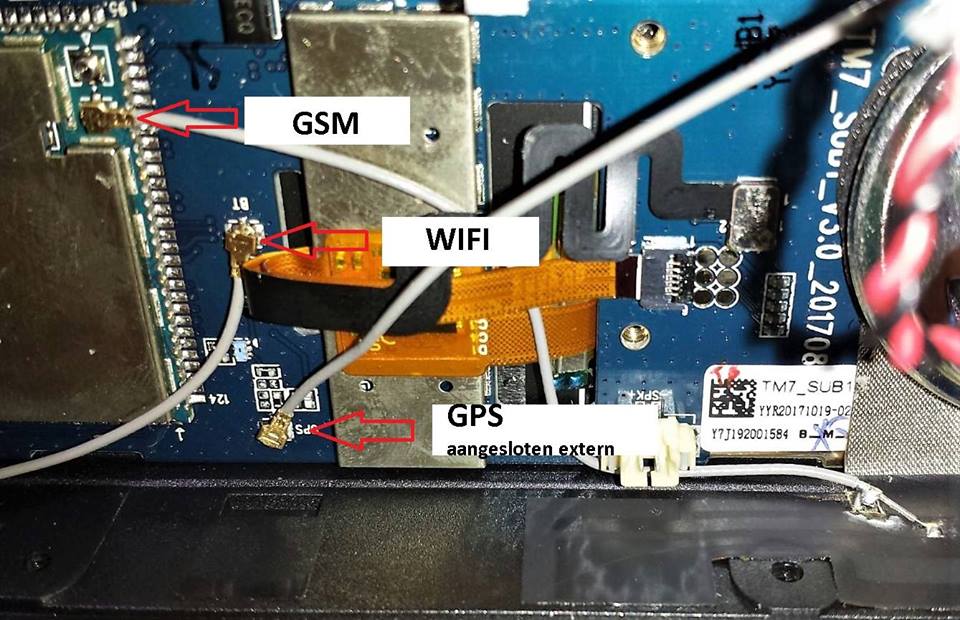
For the ones with wifi problems on the TM7; this is a photo manual that a good friend of mine made. I will try to translate te text on the pics as good as possible. The reason for the bad signal is simple: inside the antenna is simply not connected.
1 – Remove the tape and plastics. Afterwards you will see the whole motherboard.
2 – Plastic and tape that needs to be removed.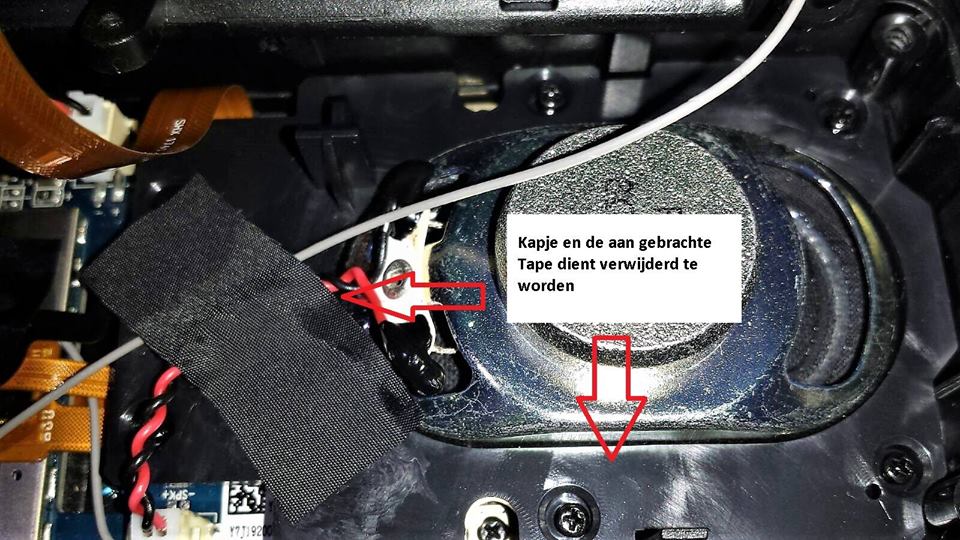
3 – Be careful when removing the tape. The connector can be damaged easily.
4 – Motherboard ready to tweak.
5 – GSM, Wifi and GPS (connected to external)
6 – End of antenna and connector.
7 – You can clearly see the connector that we will connect to the GSM or wifi connector on the board.
8 – The TM7 does seem to have an internal GSM antenna. The connection on the outside is not connected to GSM.
9 – The TM7 does seem to have an internal wifi antenna. De connector on the outside is clearly not meant for wifi.
10 – You have 2 possibilities now:
1- External to GSM
2-External to wifi
Depending on how you will use the device you will have to choose on what to connect.
11 – In this case we chose to connect wifi. You can easily change this later on.
Credits: This photo report has been made by Marcel Goedemans and translated by Filip Everaert
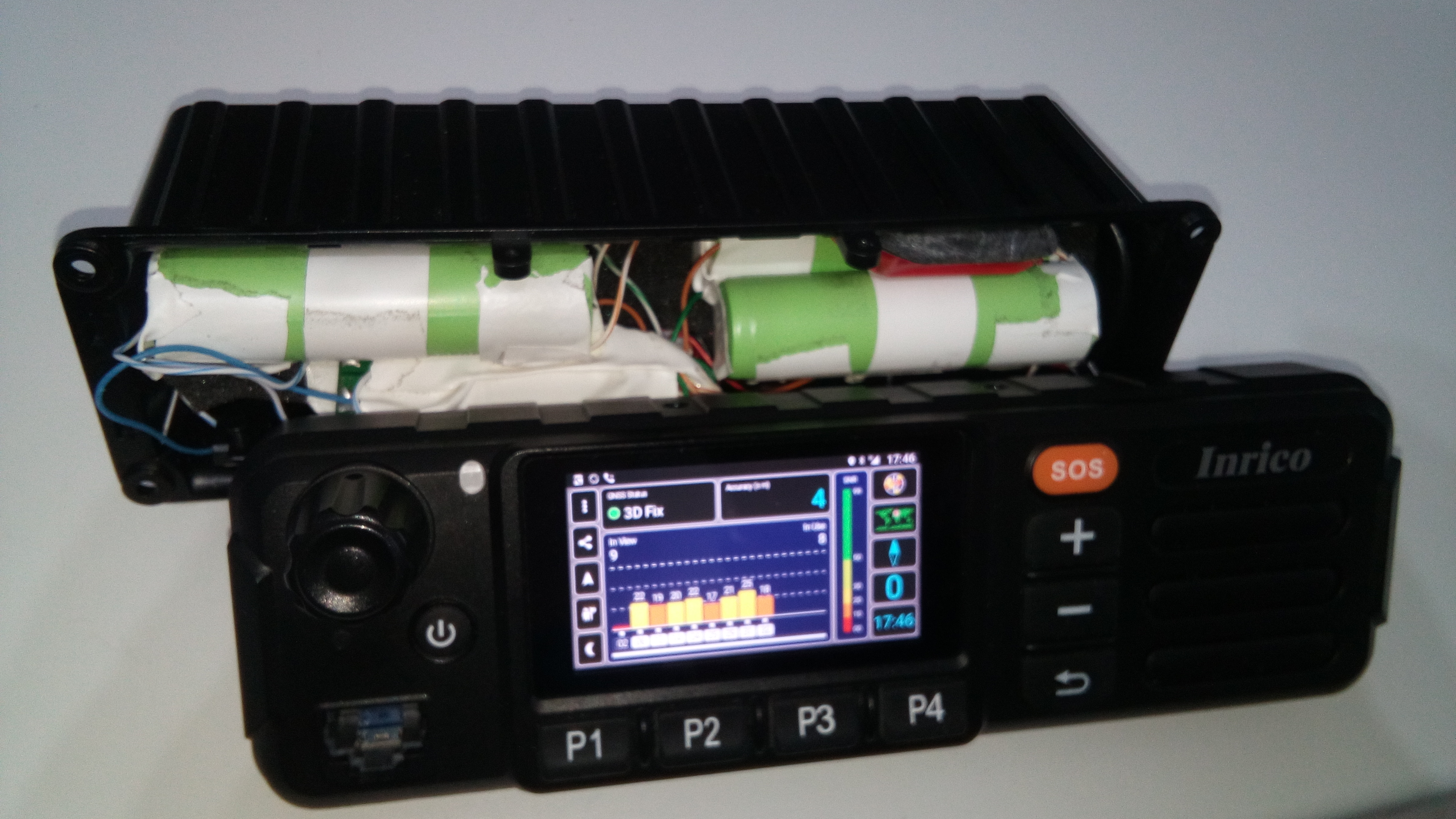
Internal Battery Modification
A lot of people are complaining including me, that in modern cars the 12V supply cuts the supply to TM7 when ignition is off. I blame emissions and political correctness. Bit like the auto stop start button for the engine.
I got tired of this battery issue, because TM7 is slow to boot and in fairness not the fastest Android I have to cope with.
A friend suggested 18650 Cells were worth a look, I had not realised they are used all over the place incl vaping devices and laptop battery packs. As I have no experience with LithIon batteries I had some fear this was going to go badly wrong.
I ordered 3400mA Sanyo cells with metal solder tags, to make life a bit easier on the build.
I also realised LithIon batteries need a proper charger circuit. Having trawled that well known auction site I discovered you can get 2,3,4,5,6 cell charger circuits. I decided 4 cells was probably more than I need but I had the room inside the TM7, so 4 cells it was. Also, I got a 15V switchable 3A power supply which could do the charging.
Id already opened the TM7 to install the sd card, so I knew the first thing to do was remove those 2 weights on the board. This makes ample room for 2x 18650 cells on either side.
Having wired them up according to diagram supplied with the board (it could be any , there are too many to specify) and made sure everything was correct in terms of polarity, and also insulated. I put some foam in the back of the case on either side to stop the batteries rattling around. That also keeps them secure. The DC output from board I soldered paralell to underisde of pcb with plus and minus going to respective tracks.
However, I should suggest that a fuse should be fitted and even one you can mount on the back to screw in ie a holder, or at least an inline fuse in case of something shorting or whatever. I didn’t as I had nothing on the desk to hand. A toggle switch may also be useful if you manage to crash the android and you need to fully power down the unit. You really don’t want to reopen and desolder wires after this job again.
I charge it for 8 hrs and I end up with literally 24 hrs full use. My intention was 7.8hrs in the car, but its exceeded way beyond what I required in terms of capacity. My guess a 3 cell arrangement would probably work. Just get the correct charger pcb.
Current, the TM7 draws 130mA in standby and max about 240mA, this is tiny in real terms as its just a telephone in a large box. So , 18650 cells are a little overkill but it works.
GPS Internal Antenna Modification
Due to my lack of tolerance regarding cables in the car I decided to put the GPS module into the TM7.
So before I decided to rip the gps antenna apart I checked how it worked inside the house. No surprise it was fine, so that was my trigger. The gps antenna is plastic cased so a sharp blade and a pliers was used to break open the case. Its sharp and brittle so expect bits of plastic to fly around workshop.
Having extracted it, I allowed 3 or 4 inches of coax cable and then cut it. I don’t need all the extra length anyhow.
Use a super fine soldering iron for surface mount, reason is no the coax, but the socket on the TM7 is difficult to get at and there is Very little clearance to tap the centre pin for connection. The braid is easier to solder to it. As we have no other option due to impossible thin coax coming from PCB, I wasn’t going to try and cut it open and go that way. Remove socket and put in vice or clamp to hold it as the soldering is awkward., I got it connected anyhow and I put the antenna snug on right side of internal back case above the battery I had already fitted.
The drop in signal inside the car is neglectable and I have it shoved down between gear box and seat. On dash the signal is full.
Good Luck.
Do at own risk. I do not accept any responsibility if something goes wrong or on fire etc. I would suggest these mods could be improved somewhat in terms of safety and general risk. These were carried out as a one off test, I would prefer manufacturer would actually do these as an option on purchase. Having to do these was out of necessity and frustration.
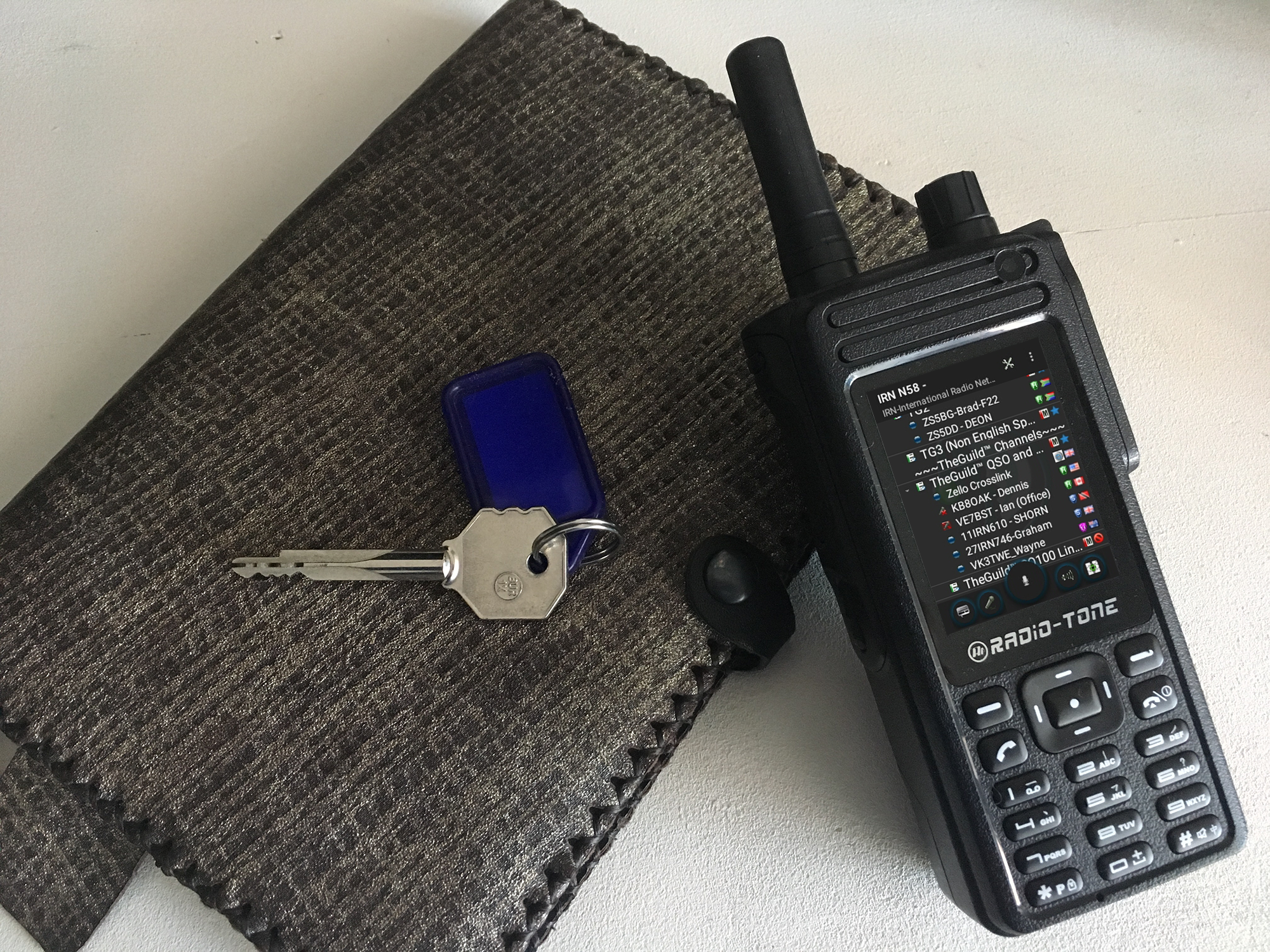
The Reality of Amateur Radio in 2018
by Chris G7DDN
What is the greatest hobby on earth? Now there’s a question!
For many of you reading this article, the answer will be clear – Amateur Radio. It’s a hobby that delights, excites and, at times, frustrates in probably equal measures!
But it is also a hobby that has historically pushed the boundaries of technology – and often asked questions no-one had even thought of asking.
The Pioneers
I love the fact that the history of our hobby is littered with the regulatory authorities of their day allowing us access to bands considered “useless” and then watching as we showed over time what immense value they could have – yes, even the most supposed “line-of-sight” bands.
It is somewhat ironic today that the most in-demand spectrum across the world commercially is VHF/UHF and Microwave, the most “line-of-sight” bands discovered in the 20th Century.
Here in the UK, large swathes of this spectrum are constantly being re-jigged and subsequently “sold off” to the highest bidders (something that has always struck me personally as slightly obscene, but that’s another story…)
Back to reality
The reality though for perhaps the majority of Hams on a day-to-day basis in 2018 is not so rosy.
I switched on 160m the other day and was faced with S9 of noise across the band. It was S5 only a couple of years ago. I’m lucky apparently – many people are getting S9+20dB or more of noise, on several bands…
As Hams, we face challenges every day from local sources of interference; power-line adapters, non-compliant devices imported from abroad, hissy routers, noisy house appliances, power supplies and all other manner of electronic hash. It doesn’t seem to be getting any better…
Then we have the Home Owner Associations coupled with the newer restrictive covenants that stop us putting up antennas, whether it be an 80 metre long wire or a 60 foot high tower. We have neighbours complaining about eyesores and about interference from “that Radio Ham” up the road.
We might think an antenna mast is a thing of beauty, but we have to concede that most of our neighbours will disagree – sometimes, most embarrassingly, led by our own XYLs!
A Means of Escape
For many, portable operation offers some escape from this, but not everyone has the motivation to climb a mountain with QRP gear and play SOTA, very laudable though that is.
If the only Ham Radio we can play with is limited to reasonable weather and a trip out, most of us are not going to be playing a lot of radio that many days of the year, are we?
At least mobile operation helps out here and has saved the day for many of us on occasions.
Perceptions
Then we struggle with the fact that we are perceived, rightly or wrongly, as being old-fashioned, fuddy-duddy and out-of-touch.
When you consider what Hams have contributed to the history of Communications, this is the height of irony.
The very people who, in effect, discovered and perfected modern-day communications, that everyone from schoolkids to governments rely on, are now reviled as being as old-fashioned as 78rpm shellac discs!
Shall we just give up then?
So what is the point of continuing in the hobby? Many have decided they won’t!
The numbers leaving the hobby, anecdotally at least, seem to be increasing. I often see ads online where complete stations are for sale, and where the owner says something like “giving up after 35 years – too much noise – too much hassle…”
Now you may be fortunate enough to live somewhere really electrically quiet – or you might be able to afford a huge farm or ranch in the countryside where there is little or no electrical noise – but the vast majority of us are not going to be able to do that.
Another way out?
Is there a sense of “If we can’t beat them, join them”?
Is one solution to take Ham Radio and move it into that realm that we perhaps secretly despise and yet simultaneously almost adore? The online arena?
I find it slightly odd that, as hams, we are more than happy to embrace the internet and computers when it suits us – for example, CW-ers make extensive use of the Reverse Beacon Network, Datamodes enthusiasts embrace programs like PSK Reporter – DX-ers rely on their preferred cluster, and so on.
We all probably have our favourite logging software, our favourite contesting programmes and websites we frequent, even if it is just to have a moan!
It’s too scary!
But are we just a little too apprehensive to “go the whole hog” and accept the Internet for what it already actually is? A man-made alternative method of propagation? Is this one reason why the whole “Network Radios’ phenomenon is so difficult to comprehend?
One well known UK ham (and regular author for one of our Amateur magazines here) wrote to me with commendable honesty recently. He explained that he was struggling in his thinking about the Internet being a form of propagation, despite the fact that intellectually he can see that it clearly is!
He was, in effect, trying to come to terms (just as I did initially) with even understanding that there could exist another form of propagation for our signals, man-made at that.
He did go on later to acknowledge that the real issue for him, was not that that this form of propagation existed, but that it was “always there”. (To be fair, that does make it different!)
Does it have to be hard work?
But this got me thinking too!
Have we got so used to Ham Radio being so much like “hard work” that if technology creates a means of propagation that makes our lives easier, we almost have to pooh-pooh it?
Is there a bit of an attitude issue? You know the kind of thing… “I had to work hard to work VP8G, so why should you be able to do it more easily?”
A new playground
In 2018, the technology available to Hams has provided us with a new playground (internet propagation) – it’s similar to, and yet very different from, the old playground (ionospheric & tropospheric propagation – which by the way, is still there for us too – it hasn’t gone away, we can and should still use it!)
Who says we can’t play in both playgrounds at once? Surely it is a case of both methods of propagation being usable, if that is what makes you happy?
There is something in human nature that doesn’t like others having it easier than we had it, but I would love to see Amateurs being open to be more accepting of new technologies in the hobby and realising that 21st Century Amateurs’ interests are, by virtue of the times we are living in, just different from those of 20th Century Amateurs.
There’s nothing wrong with that – it just is what it is!
The License Issue
For some of us, it’s difficult to get our heads around the new technologies, simply because of all the hard work we had to put in to gain our licenses. This now could be perceived as partially redundant, once we get our heads around the “Internet as a means of propagation” argument. After all the Internet is open to everyone…
We all have a tendency towards defensiveness – this is partly because we have something other people don’t have – a Ham license.
But again, putting this in perspective, and oversimplifying a little, possession of this means that we just have specialist knowledge about (mostly) building and testing transceivers (and maybe some knowledge of CW)
Are these the highest priority for a lot of hams these days?
I like what the RSGB President, Nick Henwood G3RWF, observed at his Society’s National Convention last October, that 20th Century Hams were more likely to be interested in mechanical & electrical solutions to problem solving, whereas 21st Century Hams are far more likely to look for solutions to issues in software.
That is an interesting way of viewing the change in the hobby over the last 30 years or so…
Where does all this lead?
Who knows? Isn’t that the most exciting thing?
SDR technology is transforming HF, computer technology is transforming the likes of CW, Datamodes & DX-ing, (just look at the rise of FT8!) and modern communications technology and its concomitant infrastructure is providing us with the ultimate change – an alternative means of propagation.
So have fun with RF – in all it’s forms!
So yes, go ahead and play with those Network Radios that use the Internet – make Ham-friends around the world.
Communicate with each other, use software, use Boat Anchors, use QRP CW, use valve radios, use big antennas, use minimal antennas, use internet-connected nodes, take part in contests, work through satellites, use D-STAR – do as much as you wish!
Have fun with RF in all its many forms – the Ham bands, yes, but also the cellular bands, the wi-fi bands & the bluetooth bands – especially if it gives you pleasure!
After all, isn’t a hobby ultimately supposed to make us happy?
Perhaps the saddest “Reality of Amateur Radio in 2018” is that, to listen to some folk in the hobby, you could be forgiven for thinking that it’s main purpose was actually to make Hams as miserable as possible!
Let’s use all the wonderful technologies available to us in 2018 and beyond – after all, next year there will probably be yet more new toys in the playground!
I, for one, can’t wait!
© March 2018 – Chris Rolinson G7DDN
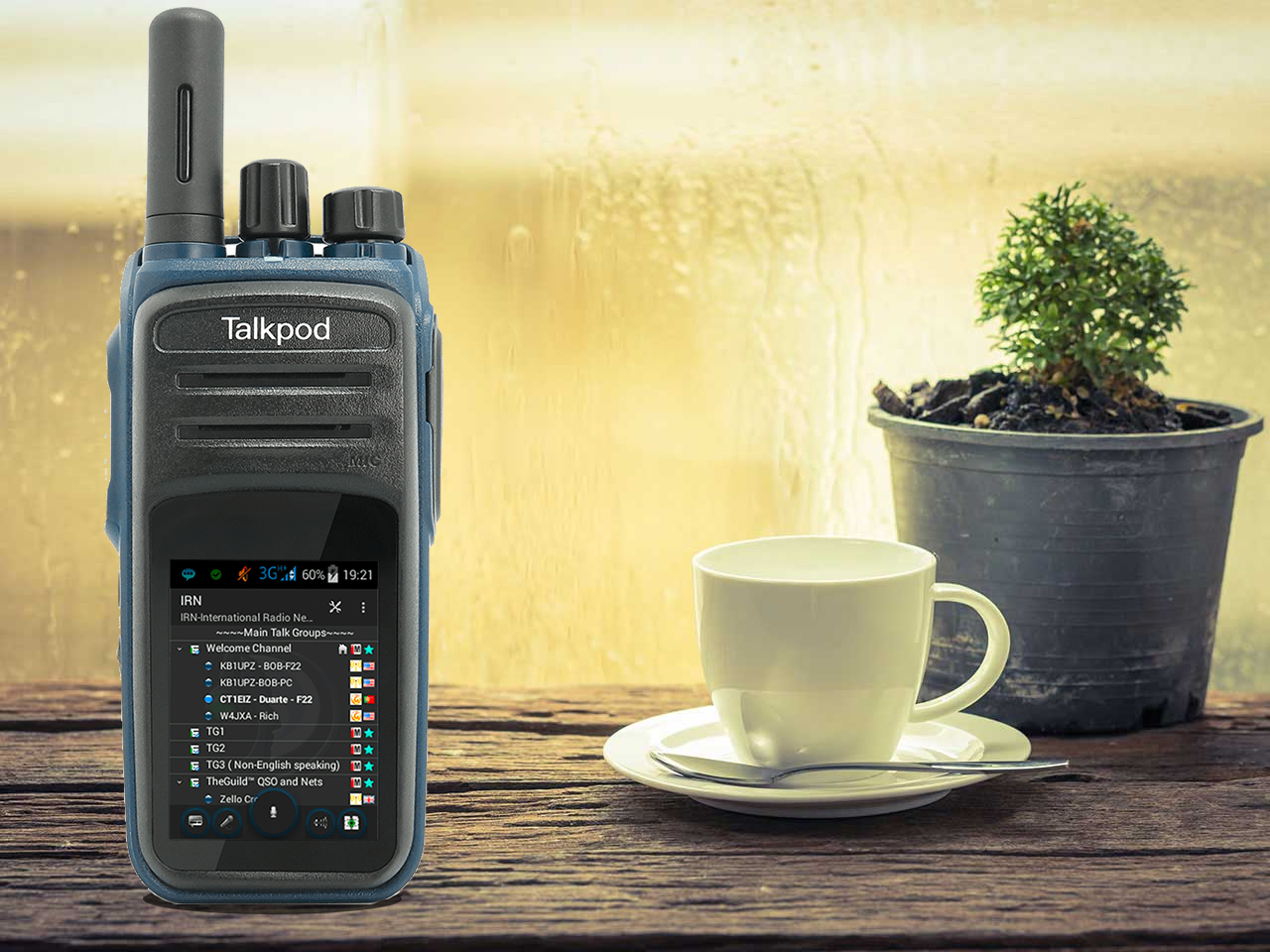
Three Letters to a Magazine
by Chris G7DDN
Today was “Porn Magazine” day!
Before you jump to rash conclusions, this is my wife’s description of the day in each month when the Radio Society of Great Britain’s monthly journal ‘RadCom’ hits our doormat.
She knows I will be perusing and purring over the articles and adverts, looking to see what is new in the world of Amateur Radio.
If only there were a glossy glamour photo of the new Icom 7610… …oh there is, yay!
The Last Word
Today though, it was not a new piece of radio equipment or a particularly inspiring piece of writing that caught my attention. Today I was particularly struck by a thread of letters to the editor, in what is known as the “Last Word” column.
There has been a particularly interesting set of opinions expressed about new technology and its impact on our hobby. And if I am honest, I hope I am not the only one somewhat concerned about what I am reading.
Magic?
Correspondent number one was recounting the magic of amateur radio and how it is our joint responsibility as Hams to reach out to others to increase our numbers – all good stuff.
But he then went on to say and I quote “…of course the young will have their iPods, iPads iPhones and the like, but there is no ‘magic’ with those devices”
I am sure the writer is not trying to wind anyone up when he writes this – it just betrays how difficult it is for us older hams to see the world through the eyes of people younger than us.
But let’s be brutally honest, surely this represents a huge misunderstanding of where 21st Century people are.
Try telling 99% of today’s population that there is no “magic” in their mobile devices!
A device that is a touchscreen pocket computer; a device more powerful than a desktop PC from only a few years ago; a device that allows instant communication world-wide with HD live video in addition to audio and instant messaging; a device capable of storing your complete music library on it…
Seriously? That is not magic? It looks like magic to me! A small slab of glass which does almost anything in the communication sphere that you can imagine? Wow!
Remember Windows 3.1?
A reality check for us oldies!
Most under 30s do not remember a time before a “Start” button in Windows! (Just let that sink in!)
Most under 30s have no concept of what a “tuning knob” on a radio is for.
Most under 30s have no concept of what Ham Radio actually is, does or understand how it works (and they show little interest in wanting to know either, from my experience!)
However, most under 30s own at least one smartphone, tablet or computer and probably know how do some level of coding on it too.
This shows the scale of the task we are up against in getting new people interested in our hobby. Sadly, we are perceived, if we are perceived at all, as being old fashioned, out-of-date and out-of-touch.
Electronic Scrap
But these were not the only comments that struck me in a less than impressive way.
A second writer noted that “…amateur radio communications are point to point with no enormous infrastructure in between, other than dear old Mother Nature! Take that infrastructure away and all those much-hyped wonderful devices would be so much electronic scrap!”
OK, I would argue the assertion that all Ham Comms are point-to-point, but I can see what the writer is saying.
But when I actually think about it, in the 25 or so years that I have owned a mobile device, I cannot recall one time it didn’t have a connection to the network.
Millions are spent improving the Internet and particularly the mobile access to it, both in terms of speed and coverage. Yes it can be turned off, yes it is vulnerable to malicious intent, but for 99.9999 recurring percent of the time, it works!
I would posit that there is precious little chance of these devices becoming “electronic scrap”, except in an apocalyptic scenario…
It’s the End of the World…
…which brings me to the third correspondent.
He predicted that, in an Armageddon event, “cellular phone networks, social media, cash machines, local authorities, food supplies, power stations, water supplies, gas and electricity and fuel producers, the military, police, fire and ambulance services.” would all close down.
He concludes that “Amateur Radio and RAYNET could then become part of the few remaining communicating methods left in the country.”
Again you can’t disagree on the surface and I do get the point.
But really, if all these devices and organisations have gone down in an apocalyptic event and it’s every man for himself, I don’t think my first thought will be to spend time erecting a 40m dipole and using my EMP-protected (you had thought of that, hadn’t you?) FT-817 to see if I can make contact with some other poor starving members of the human race, who are also trying to survive the aftermath…
I do hope the letter authors will forgive me, as I do “get” where they are coming from, but I really feel they are missing the most important point.
The Internet is the Medium
That point is that, in the 21st Century, we have a new means of propagation that pretty much everyone can, and does, already access (without exams and a special licence) – the Internet.
And it would be remiss of us to ignore that or worse still, belittle it, just because it is new, man-made and not the ionosphere that we all love so much!
The ionosphere is a fantastic natural resource, though with S9 of noise in most urban settings these days, it is sadly becoming increasingly difficult to make meaningful contacts in the way we used to. Like it or not, the Internet is the 21st century propagation medium of choice.
What’s this to do with Network Radios?
Here we have devices that, in one way, are not radios in the normal sense, but that still use RF to communicate. Radios that do not use the ionosphere, but use this newer means of propagation, the Internet.
I think the majority of people these days can relate to these devices – they are familiar enough to be comprehensible, but different enough to introduce them to the delights of 2-way communication.
In other words, it’s a potential practical route in to our form of radio communications in general, and Ham Radio in particular.
Yes, some may not progress all the way to a Ham License, but some might and that has got to be a good thing – we need to start where people are and with the technology they use every day.
Surely we cannot offer them what seems, on the surface, to be an “inferior” form of communication, coupled with an exam, as the sole means of entry to what is, in the end, a hobby?
I fear the current state of affairs in Ham Radio could well lead to our extinction as a hobby (well before the end-of-the-world event predicated by the writer of the third letter to RadCom.)
Honey, I Shrunk the World!
Years ago, communicating long distance was only possible by expensive operator-placed telephone calls or by Ham Radio. Not so now – the mobile internet has shrunk the world and Ham Radio needs to redefine itself to remain relevant in the 21st Century. I really don’t think we will achieve that by suggesting there is no “magic” in mobile devices!
In fact, we cannot assume anything anymore – people do not have any “context” that allows them to understand what Ham Radio actually is, so we have to find other ways to relate to them. Starting with devices they already own and have in their pocket with them is surely one relevant way to do that. Network Radios are exactly the kind of device that can build on that interest.
Using Android OS, using a touch screen, able to use apps they already use, able to be a phone, an internet device, but setup for amateur-style communications, they just might be the perfect hybrid device, or at least the start of development towards such a device.
I would urge all Hams to keep an open mind about this subject and not dismiss the Network Radio phenomenon out of hand.
Where it will all lead, who knows? But it could be to a much brighter future than many fear…
March 2018
N.B. Chris is giving a presentation on Network Radios at the Wythall Hamfest near Birmingham UK on Sunday 25th March 2018 at 11.00am. All are welcome.

What if you could have a network of handheld and mobile radios with global coverage? Forget about expensive repeaters and licenses. Everything will work via the cellular 3G/4G network.
Either you want 1-to-1 or 1-to-many radio communications, this is for you.
No range registrictions. If you have cellphone coverage, you are connected! This means that each radio can be in different countries, and you are still in touch with your co-workers.
What distance do PTT4U radios cover?
There is no limit. As far as you have GSM/3G/4G or WiFi(Android models) signal you will be in reach. This means that you are only dependent on the cellphone carrier service, or a WiFi hotspot.
Why is this better compared to traditional walkie talkies?
Traditional two way radio will always be limited by distance and interference. As we work with a digital connection that relies on cellphones carriers, you will always experience loud and clear interference-free communications. Besides, you don’t need to invest in expensive radio infra-structures, like repeaters, towers, antennas or leasing sites.
Who can benefit from PTT4U?
Taxi & general transportation companies, law enforcement, private security guards, construction sites, logistics, box movers, agriculture industry, and anyone else how needs 2-way professional radio communications without range restrictions.
I need to cover a wide area and in multiple locations. Do I need a set of repeaters and antennas?
No. Our service uses the network of the GSM/3G/4G carriers. You don’t need to invest on any network infra-structure, besides the mobile or hand-held radios.
Does it work on any country?
As far as you have internet access (via 3G/4G or WiFi) then you can use our system, regardless the location.
Can the users talk between them, if they are in different countries?
Yes. Any user can talk to any other user, regardless the location.
Can I use my PTT4U radio as a normal telephone?
All our android based radios can make and receive phone calls and SMS/texts. The non-android based models can not be used as phones.
Can I use any SIM card?
Yes, you may use any GSM SIM Card. All our radios are SIM unlocked and compatible with any GSM/3G/4G/LTE Network.
Do you supply the PTT4U radios with a SIM card?
No. You should insert your own SIM card.
What comes with each radio?
Every radio package includes the radio, a charger, battery, antenna, belt clip and usb cable. The mobile radio still brings a mounting bracket, microphone and an external GPS antenna.
Do PTT4U android radios require a SIM card for WiFi strict usage?
No. If you just want to use a WiFi signal, then a SIM card is not required.
Can I use my own android smartphone with this service?
Yes. You just need to install our PTT4U application on your smartphone.
Can I use PTT4U radios with CDMA carriers, like Verizon in the US?
No. All our radios require a GSM-based carrier. Our 4G/LTE radios can not be used with Verizon, because they require pre-approval of each device on their network.
Can I use the PTT4U radios with AT&T or T-Mobile, in the US?
In the US, our radios will work fine with AT&T and T-Mobile. In Europe, Australia and Africa will also work without issues.
Can I use PTT4U radios when I am off-grid, at sea for example?
You need an internet connection to use our radios. You may use a satellite hotspot like this one that will give you global coverage, even off-shore.
What happens if I don’t have internet?
If you can’t get 3G or WiFi then sadly it will not be able to connect to our network. However, you still might be able to use it as a normal phone if you get enough GSM 2G signal.
What is the function of the SOS button on the radios?
The SOS button will send an alarm to all users, showing the location of the user who pressed the SOS button.
How much data do PTT4U radios require in a month?
For a regular use, 500 MB data plan will be enough. In extreme conditions, where communications take place for long periods, 1 GB data plan may be required
Do you offer a dispatch system?
Yes, you can install our dispatch system on any Windows PC and contact any users, check their position on the map, speed, send personal messages, make private and groups calls.
Can I check the GPS location of the users?
Yes, you can check realtime location of all users and check their tracking too.
Can you define talk rights, and profiles permissions for each user?
Yes, all those details can be set.
Can PTT4U radios make private and groups calls to other users?
Yes, you can make both type of calls.
Can PTT4U radios send private messages to other users?
Yes, you can send private messages to any user.
Do I have to subscribe to any service to use PTT4U?
Besides having a data plan with your cellphone carrier, you need to subscribe our PTT4U yearly subscription.
How much do I pay for the PTT4U subscription?
Our yearly subscription price per radio can be checked here.
Why not just use a phone to talk to each other?
Our state-of-the-art network is almost instant, less than 1 second to the point of pressing the PTT on one radio to your voice coming out the other one or ones, plus you can talk up to 10000 at the same time, ideal for communications to field workers or patrol staff.
What happens if the server is offline?
That is very unlikely. We have 21 back-up servers, strategically located, hosted by state-of-the-art IDC (Internet Data Centres) in the North & Central America, Brazil, England, Germany, Hong Kong, Australia, Singapore, and other locations. In case of service degradation, you can count on our highly qualified IT Team expertise plus a decade of experience in the PTT over Cellular (POC) industry.
How can I pay the radios?
You may pay with Paypal or any credit card.
How can I pay the subscription?
You may pay with Paypal or any credit card.
Can I pay the radios and the subscription together?
Yes, using Paypal. We will provide you a recurring bill, where the first charge is the cost of the radio plus the first year subscription fee. You will see this detailed as “signup fee” on each product description. (the radio is included)
Do you offer other payment methods?
Not at the moment.
Can I become your reseller?
Yes, we are looking for resellers worldwide. Please contact us. You can check our list of resellers here.
I need a large amount of radios. Can I try before I buy?
Not at the moment. But you can buy one of our Startup Packages at a discounted price, before you invest in a large quantity of radios/subscriptions.
Can I get a free trial?
We don’t offer such program at the moment. We are very confident that you will love our system anyway.
I need 10 subscriptions or more. Can I get a discount?
Yes, see our discounts here.
If I order today, will I be billed today? And when does the subscription start?
You will be billed in the moment you complete your order. The 1 year subscription will start counting only when you receive the radios and ask us to activate the subscription. Like this, in case you fail the next recurring payment, you still have some time to re-active the subscription, without loosing PTT service.
Can I get a monthly subscription?
No. At the moment, we only offer yearly subscriptions.
Do you offer API access so I can use my own software to check user locations?
Yes, you can have access to an API to use your own geolocation solutions.
Do you offer full-duplex communications?
All our android radios allow regular phone calls, in full duplex. When using radio-like communication with the PTT4U, all communications will be simplex.
Do your radios have dual SIM?
Most of our radios offer dual SIM slot. Check the specs of each radio.
Do you encrypt the communications?
Yes, all communications are encrypted by a proprietary protocol and only the network admin of your organisation has access to the historical data.
I have a large organisation. Can I manage the platform myself?
Yes, you can manage all users, groups, talk rights, etc, accordingly to your own needs.
Is this for me?
Any of the following industries can use our solution:
Transportation
Courier, Taxi, Limo Service, Tow truck, Railway, Airport, Seaport, Light rail, MRT, Logistics
Construction
Constructions Site, Cement delivery, Electrical, Excavating, Plumbing, Roofing
Security Services
Patrol Guard Service, Hotel, Condo, Offices, Factory, Sports events, Education, Fire Service
Hospitality
Restaurant, Hotel, Resort, Shopping mall, Supermarket
Government
Police, Sheriff’s Departments, Public Works, Water Departments
Private users
Many private customers use our service to stay in touch with family and friends
This is really exciting! Is this for real?
Yes, it is. And we have to agree: this is amazing! Get your start-up package today with a discount!
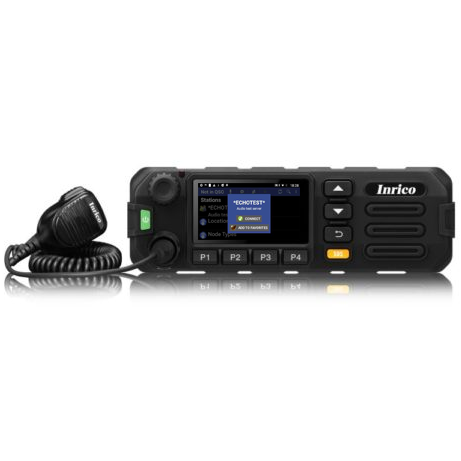
in the picture – Inrico TM-8
A Pioneering Background
I was musing recently on the wonderful history of Amateur Radio, from the early pioneers with spark transmitters and the race to get the first signals across the Atlantic, up to the Microwave enthusiasts who developed the way forward for space communications and satellite technology (and, whisper this, mobile phone technology!)
The history of Ham Radio and RF technology is inextricably linked – there was even a time here in the UK where it was believed, anecdotally, that a Ham Radio callsign would help you to get a job with the BBC!
However change came very quickly, relatively speaking, in the early history of radio. From Marconi’s experiments to the first Public Broadcast Stations was only 25 or so years. TV was only another 15 years or so behind that, and so on…
Resistance (or not feeling at “Ohm”)
Yet the history of Ham Radio is also one of resistance to change – not from the pioneers, they were often instigators of it, but from the “everyday” Hams.
Let me see if I can give you some examples, with my tongue planted very firmly in my cheek…
“That’s not Real Ham Radio!”
The early Hams used CW pretty much exclusively. So when AM arrived as one of the first of the voice modes, there was a bit of an uproar…“It’s not real Ham Radio! Real Ham Radio involves using a Morse Key! What in world is the hobby coming to, using voice to communicate over the airwaves? It’s sacrilege!”
But life went on, AM found acceptance and all was well in Hamland once again.
Then transistor technology arrived in the late 1940s and early 1950s, provoking quite a response. “Hang on! That’s not real Ham Radio. Real Ham Radios glow in the dark – we can’t be having this miniature technology – they’ll never last as long as valves or be as reliable”
But life went on, solid state devices found acceptance and all was well in Hamland once again.
Then SSB arrived and there was more discontent… “That’s not real Ham Radio. Real Ham Radios don’t sound like Donald Duck! It’s a fad, it will soon fall away once people get fed up of hearing those silly voices”
But life went on, SSB found acceptance and all was well in Hamland once again.
Then FM and repeaters arrived and there was polarisation within the hobby (and it wasn’t horizontal or vertical either!) “That’s not real Ham Radio. Real Ham Radio doesn’t need to use that thing on top of the hill to help your signal get somewhere! Real Ham Radio is point to point!”
But life went on, FM & repeaters found acceptance and all was well in Hamland once again.
Then Packet Radio arrived and there was real trouble… “That’s not real Ham Radio. Real Ham Radio doesn’t need one of those new-fangled computer thingies in order to work. Get your key or your mic out and start working other Hams properly!”
But life went on, Packet Radio found acceptance and all was well in Hamland once again.
Then Digimodes arrived and there was yet more strife… “That’s not real Ham Radio. Real Ham Radio doesn’t involve typing messages to other Hams – and those perishing computers again! What on Earth are they doing in the hobby?”
But life went on, Digimodes found acceptance and all was well in Hamland once again.
Then Digital Voice modes arrived and there were some very serious disagreements… “That’s not real Ham Radio. Real Ham Radios don’t sound like R2D2! Real radios don’t use the Internet to help them get round the world, they ABSOLUTELY HAVE to use atmospheric propagation. What is happening to this hobby???”
But life went on, D-STAR and other Digital Voice modes found acceptance and all was well in Hamland once again.
Then we arrive at today and Network Radios come onto the scene and all hell breaks loose! “That’s not real Ham Radio. This is playing at Ham Radio – there’s no Amateur RF so it is simply not Ham Radio. What is more, I worked hard for my license, everyone else should have to too! How dare people enjoy communications in an incorrect manner!”
So will life go on and will all ever be well in Hamland again?
The 21st Century Challenge
This is why the advent of Network Radios represents such a challenge to us as Hams – it is causing us to completely rethink what it means to be a Radio Amateur in 2018 and beyond.
And we will have to start facing up to questions similar to these…
What about our bands?
As Hams we are very “attached” to our bands. Whether it be 160m or 2m, we almost have a psychological sense of “ownership” of them.
We have “favourite” bands, we have bands we never frequent.
We even have “our” spot frequencies and some Hams will get somewhat “assertive” if a fellow amateur who is not in their “group” dares to use “their” frequency!
And yet in the 21st Century, I believe that the whole concept of bands & frequencies is becoming ever more fluid. Why would this be?
An example from Broadcast Radio
Not that long ago, we could tune into broadcast stations on Long Wave (LF), Medium Wave (MF), Short Wave (HF) and FM (VHF Band II). Stations frequently referred to themselves by frequency: “247 metres Radio 1” or “1152 AM” for example. It was seen part of the station’s identity – many had the frequency in their station names!
But today, we increasingly hear less of this. When you listen to broadcast stations these days, they seem to be eschewing giving out frequencies, instead they just announce that they are on “FM, DAB and Digital” or something similar to that.
Why? Because radio is something you probably increasingly consume in one of two ways – either digitally (via DAB or Satellite or similar means) or by streaming via the Internet. Frequencies and by extension, bands, are not as relevant as they once were.
Moving Out!
The large broadcasters are also increasingly moving away from “traditional” radio.
On Short Wave – only a few countries & various religious groups seem to operate there now. The big guys are moving out of Long and Medium Wave too. If commercial broadcasters are moving away, we need to ask why.
Do Bands matter?
I have a suspicion that this is, in part at least, because bands and frequencies don’t matter so much these days. Domestic radio appliances are more about push buttons and screens that get you to your station instantly, rather than tuning dials with frequencies. It’s the end product that is important, not necessarily the manner in which it gets to you.
Who tunes a modern broadcast radio in these days with a manual tuning dial? Anyone? It was the main knob on all radios not that many years ago! I can even remember tuning old VHF TV in with a dial in my early days on this planet – that really seems odd now!
Going one step further, many broadcast stations are not even using direct RF at all these days! We still refer to them as “radio stations” (or occasionally “Internet radio stations”)
Is there any reason to think Ham Radio as a hobby will not invariably move in a similar kind of direction? One of our strengths historically as Hams has been that we are good at embracing new technologies and adapting them for our own uses.
The point I am leading up to is this – I suspect “bands” and “frequencies” are not really as big an issue in the digital age as we might like them to be.
In essence, bands only exist because of propagation.
Propagation again
160, 40m, 20m,10m, 2m etc. are all, in reality, “line-of-sight” bands. To over-simplify the subject, it is the ionospheric or tropospheric layers that enhance this line-of-sight propagation and turn it into something else.
Each band has differing propagation qualities as a result, giving each band its “character” and for some, the study of propagation in itself is a fascinating part of the hobby.
Man-made propagation is just different
When we think of (and use) the Internet as a man-made propagating medium (which is what it is – it propagates signals around the world) then the concept of bands becomes redundant.
The Internet is like one, almost infinitely wide, worldwide “band”, constantly open S9+40 to all countries 24/7 with few vagaries – and not just for voice, but for vision and other digital modes as well.
Put like that, who wouldn’t want to use it? Would it actually matter what “band” you were (or were not) on, if there even were one?
So the concept of “bands”, by which so many of us define our activities, may be crumbling in front of us in this digital age and we may not even realise it yet! That is not to say our bands don’t still exist, by the way – clearly they do. It is just that, to many people these days, bands are a foreign concept.
And then what?
As the hobby starts to come to terms with some of the implications of this, other issues then start to arise, such as…
I expect to see a lot of discussion in the future about this – it’s actually quite exciting!
Out of the Comfort Zone…
However it will make many of us feel extremely uncomfortable – the ground is shifting beneath our feet and the traditional raison d’être of Ham Radio is waiting to be challenged to change and adapt…
I don’t see this as a bad thing – intelligent honest debate is to be welcomed. The most important thing is to keep our minds and our thinking wide open. We shouldn’t reject something just because it is new or because it challenges our preconceived ideas of where radio is going in general.
Equally, we shouldn’t throw the baby out with the bathwater and reject traditional Ham Radio as it has been for years. The Ionosphere and the Internet are complementary, not in competition.
My own opinion?
If you have read this far and you really want my personal thoughts…
Why can we not have the best of both worlds? Surely we can.
Network radios (at this stage in their development at least) are not contest radios for example, and the Internet is not yet a contest-friendly mode of propagation. (That might change of course!) so contesting is still best on the traditional Ham bands. I’ll see you on 80 metres – 59 001 OM…
However, regular reliable high-quality contacts around the world are but one thing Network Radios excel at, so why not just use that when you want to (or when the HF bands are full of noise or are otherwise dead)? I do! I don’t see the expansion of choice in the hobby as a bad thing.
Enjoyment is the key
Does the fact that I am transmitting on cellular frequencies at 800MHz, 900MHz, 1800MHz, 2100MHz or on Wi-Fi on 2.4GHz or 5GHz matter? Is there something intrinsically evil about that? Is there more virtue in using 21 MHz or 432MHz, for example? They are just “frequencies” after all.
I prefer to see myself following the motto of my local radio club, “Having fun with RF”. Whether I choose to use a Network Radio or a Yaecomwood super-duper base station is not as relevant to me. Enjoyment of the hobby is everything, otherwise why have a hobby?
Whichever way this debate goes and whichever direction this great hobby takes, my line would be to keep all the richness of every aspect of the hobby.
In other words, to go back to the title of this piece and change but one word, “It’s ALL ‘real’ Ham Radio”
© March 2018 – Chris Rolinson G7DDN
